The Grand Egyptian Museum (GEM), situated on the Giza Plateau, is set to be the world’s largest archaeological museum. A monumental addition to Egypt’s rich heritage, this state-of-the-art museum is dedicated to showcasing the country’s fascinating ancient treasures. Opening soon, the GEM will offer an extraordinary experience for visitors, allowing them to explore over 50,000 artifacts from the world’s most iconic ancient civilization. Below, we highlight key features of the museum that make it an essential destination for anyone visiting Egypt.
- Egypt Tour Magic
- Egypt Tour Packages
- Excursions in Egypt
- Cairo Tours and Excursions
- Hurghada Tours and Excursions
- Soma Bay Tours and Excursions
- Makadi Bay Tours and Excursions
- Sahl Hasheesh Tours and Excursions
- El Gouna Tours and Excursions
- Marsa Alam Tours and Excursions
- Port Ghalib Tours and Excursions
- El Quseir Tours and Excursions
- Dendera and Abydos Day Tours
- Aswan Tours and Excursions
- Luxor Tours and Excursions
- Alexandria Tours and Excursions
- Sharm El Sheikh Tours and Excursions
- Top Rated Tours in 2025
- Optional Excursions in Egypt
- Private Transfer
- Blogs About egypt
- Ancient Egypt
- What You Need To know Before Your First Trip To Egypt
- Best Places to Visit in Egypt 2025
- Top Attractions in Red Sea Resorts 2025
- Top 10 Tourist Activities in Egypt
- Top 30 Activities You Can’t Miss in Egypt
- The Guide to Guided Tours in Egypt
- Egypt’s Ancient and Modern History
- The Nile River
- The Deserts of Egypt
- Historical Sites in Egypt
- Cairo
- Alexandria
- Luxor
- Aswan
- The Red Sea
- Dendera Temple
- El Fayoum Oasis
- Bahariya Oasis
- Siwa Oasis
- Al Alamein
- Marsa Matruh
- Ancient Egyptian gods
- famous Egyptian dishes
- UNESCO World Heritage sites
- About Us
- Why Egypt Tour Magic
- Egypt Tour Magic
- Egypt Tour Packages
- Excursions in Egypt
- Cairo Tours and Excursions
- Hurghada Tours and Excursions
- Soma Bay Tours and Excursions
- Makadi Bay Tours and Excursions
- Sahl Hasheesh Tours and Excursions
- El Gouna Tours and Excursions
- Marsa Alam Tours and Excursions
- Port Ghalib Tours and Excursions
- El Quseir Tours and Excursions
- Dendera and Abydos Day Tours
- Aswan Tours and Excursions
- Luxor Tours and Excursions
- Alexandria Tours and Excursions
- Sharm El Sheikh Tours and Excursions
- Top Rated Tours in 2025
- Optional Excursions in Egypt
- Private Transfer
- Blogs About egypt
- Ancient Egypt
- What You Need To know Before Your First Trip To Egypt
- Best Places to Visit in Egypt 2025
- Top Attractions in Red Sea Resorts 2025
- Top 10 Tourist Activities in Egypt
- Top 30 Activities You Can’t Miss in Egypt
- The Guide to Guided Tours in Egypt
- Egypt’s Ancient and Modern History
- The Nile River
- The Deserts of Egypt
- Historical Sites in Egypt
- Cairo
- Alexandria
- Luxor
- Aswan
- The Red Sea
- Dendera Temple
- El Fayoum Oasis
- Bahariya Oasis
- Siwa Oasis
- Al Alamein
- Marsa Matruh
- Ancient Egyptian gods
- famous Egyptian dishes
- UNESCO World Heritage sites
- About Us
- Why Egypt Tour Magic
The Grand Egyptian Museum: A New Era for Ancient Egypt
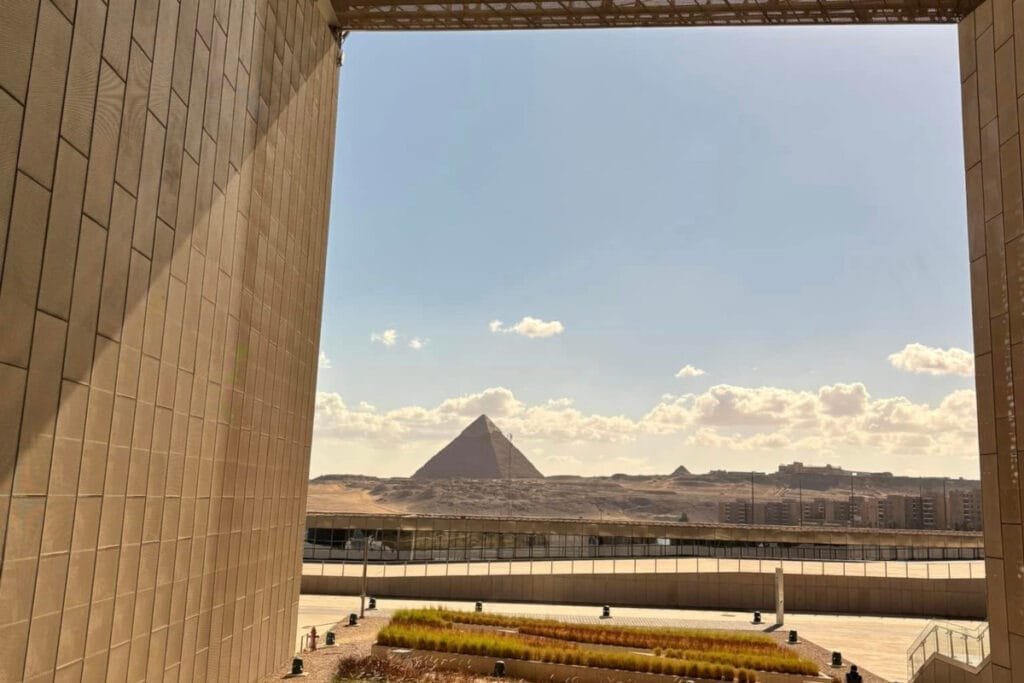
1. A Stunning Location at the Foot of the Pyramids
One of the most striking features of the Grand Egyptian Museum is its location. Positioned near the iconic Pyramids of Giza, the museum offers visitors unparalleled views of these ancient wonders. With the museum’s proximity to the Pyramids, visitors can connect the artifacts they see inside with the remarkable monuments that have stood for over 4,000 years. The vast expanse of the museum's modern architectural design contrasts beautifully with the timeless grandeur of the pyramids, creating a unique fusion of ancient and contemporary Egypt. From the museum’s terraces and windows, visitors will be able to enjoy one of the most scenic vistas in the world, with the ancient wonders of Egypt right at their doorstep. The museum’s design maximizes this location by incorporating wide, open spaces and large glass windows, creating a sense of openness and connection with the surrounding landscape. Whether you are exploring the collections inside or taking in the stunning panorama outside, the Grand Egyptian Museum promises an experience like no other, combining history, culture, and breathtaking views.
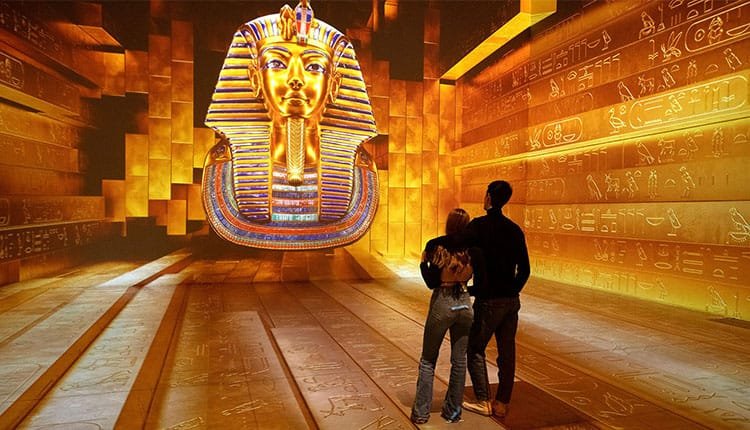
2. The Treasures of Tutankhamun
Arguably the most significant attraction in the Grand Egyptian Museum is the collection dedicated to King Tutankhamun, one of Egypt’s most famous pharaohs. The museum will house over 5,000 pieces from the tomb of Tutankhamun, offering a comprehensive look at the treasures that were unearthed in 1922 by archaeologist Howard Carter. This collection, which includes gold masks, jewelry, chariots, and furniture, will be on display for the first time in one place, providing a deeper understanding of the life and death of the boy king. The Golden Death Mask of Tutankhamun is undoubtedly one of the most iconic items in the museum, and visitors will have the chance to view this breathtaking artifact up close. The rich gold and intricate detail of the mask capture the magnificence of ancient Egyptian craftsmanship and offer a glimpse into the grandeur of Tutankhamun's tomb. The GEM's permanent Tutankhamun exhibit will be a highlight for visitors seeking to learn more about the boy king and the world of the ancient Egyptian monarchy. In addition to the famous treasures, visitors will be able to view items that were not displayed previously, offering new insights into the discovery of Tutankhamun’s tomb and the young pharaoh’s life. The exhibition’s detailed narratives and well-curated artifacts will bring the history of Tutankhamun to life in a way that no other museum can.

3. World-Class Modern Architecture
The Grand Egyptian Museum is as much a work of art in itself as the ancient artifacts it houses. Designed by renowned architect Hani Abdel-Hadi, the museum boasts a sleek, contemporary architectural design that blends harmoniously with its surroundings. The building is characterized by its innovative use of glass, steel, and stone, creating a striking contrast between modern design and ancient artifacts. The architecture seamlessly integrates modern elements with the landscape, ensuring that the museum does not overshadow the ancient monuments nearby but instead complements them. Inside, the museum features expansive galleries that allow visitors to move freely and comfortably as they explore the extensive collection of artifacts. The layout of the museum is designed to ensure a smooth flow of visitors, guiding them through different sections while showcasing Egypt’s cultural evolution across various periods. The open-plan design and high ceilings contribute to an airy, welcoming atmosphere, which enhances the overall visitor experience. One of the museum's most remarkable architectural features is its use of natural light. The building’s design incorporates large glass panels and windows that allow sunlight to flood the interior, creating a vibrant atmosphere during the day. This design also emphasizes the connection between Egypt’s ancient history and the present day.
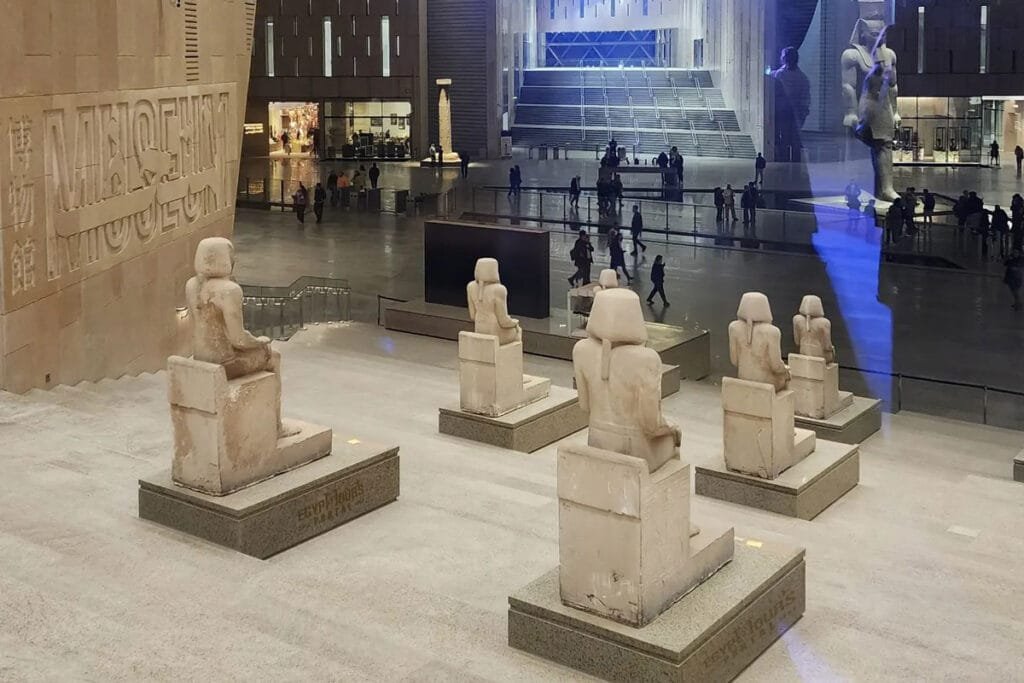
4. Expansive Collections Across Multiple Galleries
The Grand Egyptian Museum is home to an enormous collection that spans over 5,000 years of Egypt’s rich history. The museum is divided into various thematic sections, each dedicated to a specific period or aspect of ancient Egyptian civilization. The layout includes galleries that focus on the Pharaonic era, royal tombs, ancient Egyptian art, and more. Some galleries highlight key dynasties, including the Old Kingdom, Middle Kingdom, New Kingdom, and the Greco-Roman period, offering visitors an in-depth understanding of Egypt’s cultural development. One of the standout sections is the Royal Mummies Hall, which will display the mummies of some of Egypt's most famous rulers, such as Ramses II, Seti I, and Hatshepsut. This hall will be a rare opportunity to witness the preservation of ancient Egyptian royalty up close, offering an evocative glimpse into the mummification process and the ancient belief in the afterlife. Other galleries will showcase ancient Egyptian art, including stone carvings, statues, jewelry, and everyday items that demonstrate the skill and craftsmanship of ancient artisans. With over 50,000 artifacts, the Grand Egyptian Museum will offer an immersive journey into Egypt's past, providing visitors with a comprehensive view of one of the world’s most advanced civilizations.
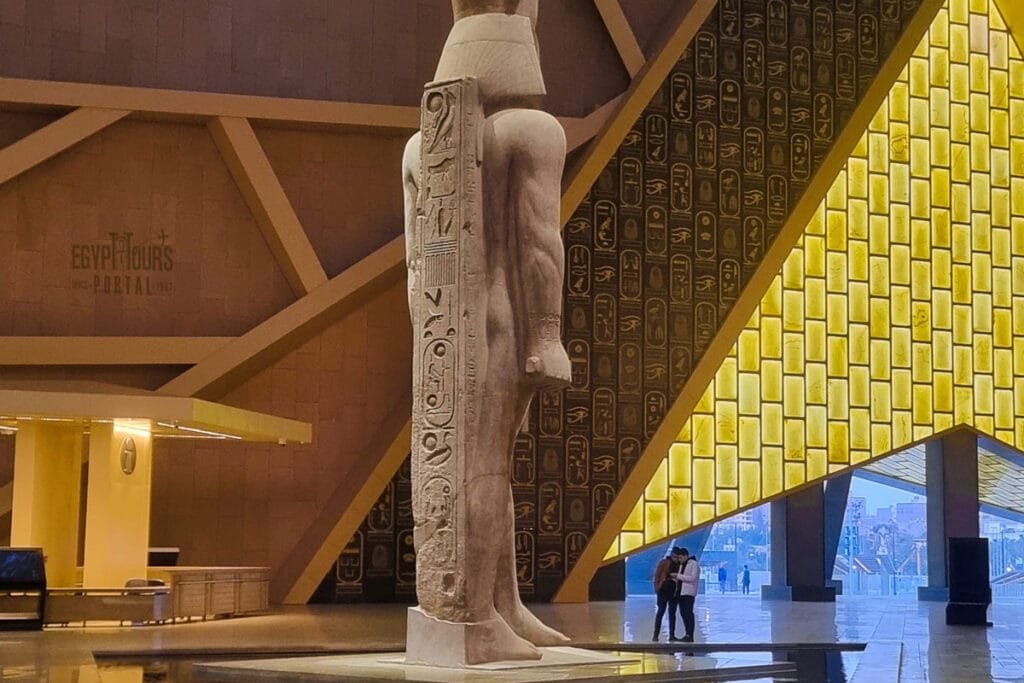
5. Educational and Interactive Experiences
Beyond the incredible collections of ancient artifacts, the Grand Egyptian Museum is also committed to educating visitors through interactive exhibits and modern technology. The museum integrates state-of-the-art multimedia presentations, touchscreens, and virtual reality experiences that help bring ancient Egypt to life in an engaging and accessible way. These interactive features will allow visitors to virtually "travel" to ancient sites, explore tombs, and see ancient rituals brought to life. Educational programs and workshops will be available for visitors of all ages, from school groups to adults interested in learning more about Egyptology. These programs will include guided tours, lectures, and hands-on activities that delve deeper into the history of Egypt, the art of mummification, and the legacy of the ancient Egyptians. The Grand Egyptian Museum aims to serve as an educational hub, promoting research and awareness of ancient Egyptian history while also ensuring that its collections are accessible to a wide audience. The museum’s commitment to both preserving Egypt’s heritage and sharing it with the world makes it a vital institution for future generations.

6. Visitor Amenities and Services
In addition to its extraordinary exhibits, the Grand Egyptian Museum will provide a range of visitor amenities designed to enhance your experience. The museum will offer spacious, comfortable rest areas, cafés, and restaurants where you can relax and enjoy refreshments while taking in the surrounding views. A gift shop will feature exclusive merchandise and authentic souvenirs, including replicas of famous artifacts, books on ancient Egypt, and locally made handicrafts. For those looking for a more immersive experience, the museum will also feature specialized galleries and temporary exhibitions that rotate regularly, offering something new for repeat visitors. To cater to international visitors, the museum will provide services in multiple languages, ensuring that tourists from around the world can enjoy the exhibits in their own language. The museum will also offer a variety of facilities for people with disabilities, ensuring that everyone can explore and enjoy the rich history on display.
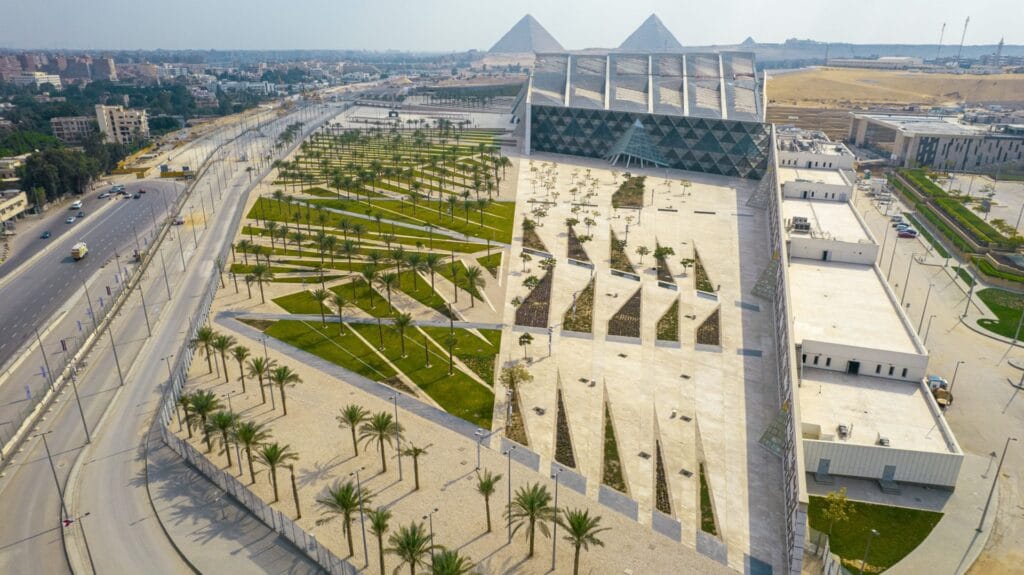
7. Sustainable and Eco-Friendly Design
The Grand Egyptian Museum stands out not only for its architectural grandeur but also for its commitment to sustainability. Designed with environmental concerns in mind, the museum features green building practices and energy-efficient systems to reduce its carbon footprint. One of the key features of the museum's sustainable design is its use of solar panels, which will help power the museum and reduce its reliance on traditional energy sources. The building's orientation and materials also ensure that natural light is maximized during the day, reducing the need for artificial lighting and contributing to energy savings. Additionally, the museum is equipped with advanced air-conditioning systems that are designed to be energy-efficient and eco-friendly, maintaining a stable temperature for the preservation of artifacts without negatively impacting the environment. These sustainable practices are part of Egypt's broader effort to create a more eco-conscious tourism infrastructure, making the GEM not only a cultural and historical landmark but also a model for modern, responsible architecture.
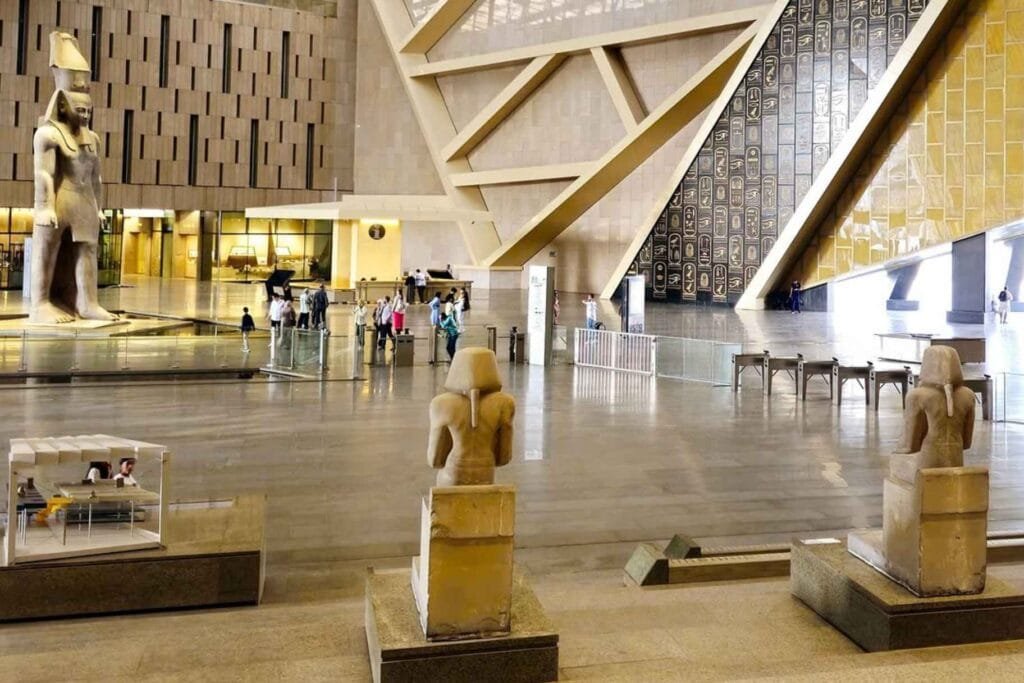
8. Cultural and Special Events
The Grand Egyptian Museum will not only be a place for permanent exhibitions but also a vibrant cultural venue for special events, temporary exhibits, and performances. Throughout the year, the museum will host cultural events that celebrate Egypt's rich heritage, such as music concerts, dance performances, and theatrical plays inspired by ancient Egyptian myths and stories. These events will bring the museum to life in dynamic ways, allowing visitors to engage with Egyptian culture in a more interactive and immersive manner. Temporary exhibitions will also be a key feature of the museum, with rotating collections showcasing unique artifacts from various archaeological discoveries, both within Egypt and from around the world. These exhibitions will provide opportunities to explore lesser-known aspects of Egyptian history, such as ancient Egypt's interactions with other civilizations, its science and innovations, and its art forms. These cultural events and special exhibits will keep the museum experience fresh and exciting, encouraging visitors to return time and again to explore new aspects of Egypt’s history and culture.
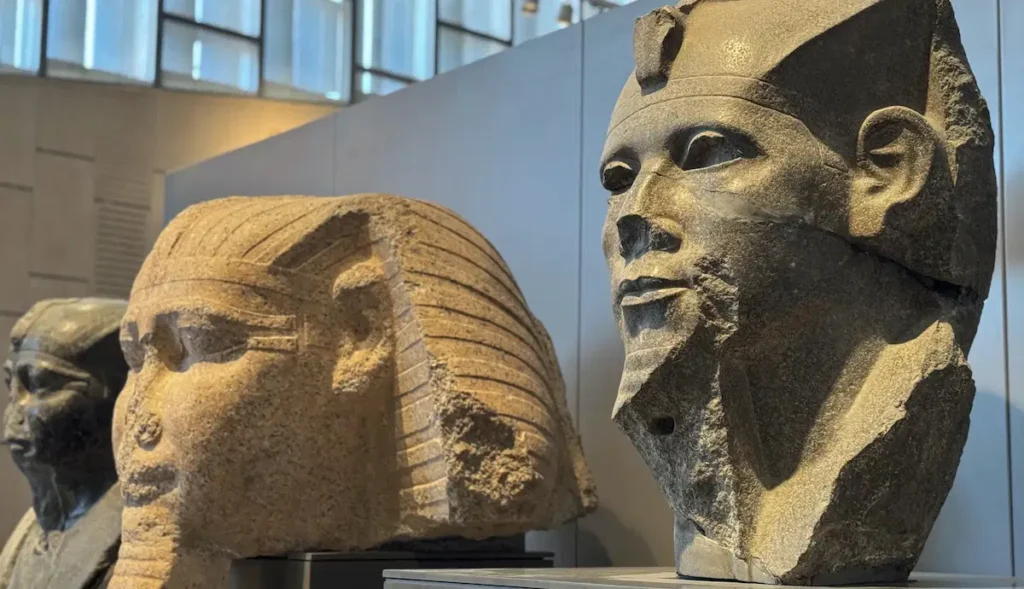
9. A Hub for Global Research and Collaboration
Beyond its role as a museum for the public, the Grand Egyptian Museum will also serve as a key research institution for Egyptology and related fields. The museum will house state-of-the-art laboratories and conservation facilities, where ongoing research and restoration work will be conducted to preserve Egypt’s ancient treasures. It will collaborate with leading universities, museums, and research institutions around the world, fostering a global exchange of knowledge and expertise in the study of ancient Egypt. The museum will also offer a research library and archives, making it a valuable resource for scholars, archaeologists, and historians seeking access to primary source materials and the latest research on ancient Egypt. By providing a space for both scientific inquiry and public education, the GEM will strengthen Egypt’s position as a leader in the field of archaeology and contribute to the global understanding of ancient Egyptian civilization.

10. Cutting-Edge Technology for Enhanced Visitor Experience
The Grand Egyptian Museum is not only a home for ancient artifacts but also an example of how modern technology can enhance the visitor experience. One of the key features of the museum is its use of interactive technology, such as augmented reality (AR) and virtual reality (VR), to help bring the ancient world to life. Visitors can interact with exhibits through touchscreens and digital interfaces, providing deeper insights into the history and context behind each artifact. The museum also offers a mobile app that guides visitors through the galleries with detailed descriptions, interactive maps, and audio guides in multiple languages. These digital tools are designed to provide an engaging and informative experience for all ages, enhancing the educational value of the museum. Additionally, the museum’s advanced lighting and projection systems highlight the beauty of each exhibit while ensuring optimal viewing conditions for delicate and rare artifacts. By seamlessly integrating technology with its exhibits, the GEM creates an engaging and interactive learning experience that appeals to a wide range of visitors, from casual tourists to avid Egyptology enthusiasts.
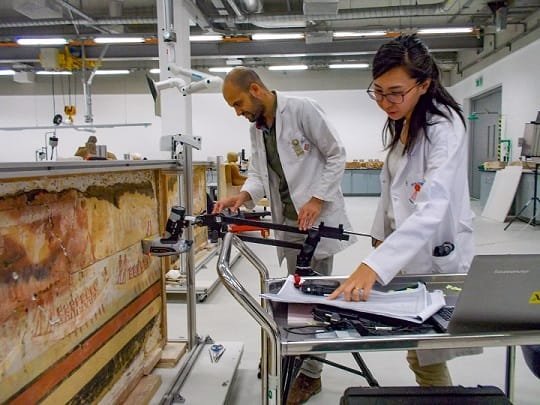
11. A World-Class Conservation Facility
At the Grand Egyptian Museum, preservation and conservation are at the heart of the institution's mission. The museum houses a state-of-the-art conservation center, equipped with the latest technology and staffed by skilled conservators who specialize in the preservation of ancient Egyptian artifacts. This facility is designed to ensure that the thousands of delicate items on display are kept in optimal conditions for future generations to enjoy. The conservation center plays a critical role in maintaining and restoring Egypt’s ancient treasures. Artifacts from the tomb of Tutankhamun, for example, have undergone meticulous conservation processes to ensure their longevity. The work done behind the scenes at the GEM helps safeguard the integrity of the country’s cultural heritage while also advancing the field of artifact conservation through research and collaboration with international experts. The public will also be able to learn more about these processes, as the museum offers occasional behind-the-scenes tours and exhibitions that highlight the complex and fascinating work of conservation. The Grand Egyptian Museum’s commitment to conservation ensures that the artifacts in its care are preserved for study and enjoyment by future generations, contributing to the ongoing legacy of Egypt’s ancient civilization.
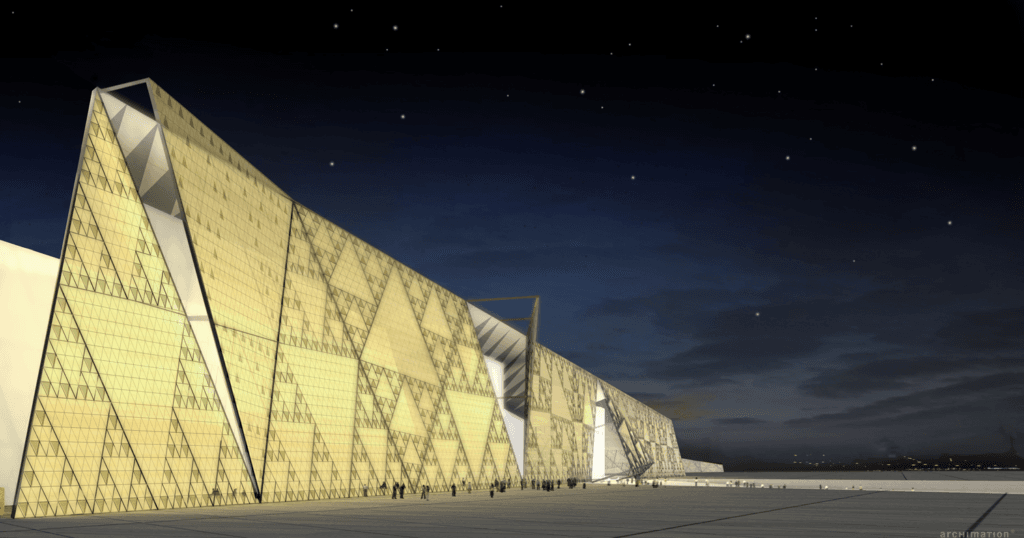
12. Expansive Outdoor Spaces and Gardens
The Grand Egyptian Museum is not just about its impressive indoor galleries; it also features vast outdoor spaces that offer visitors a chance to relax and enjoy the natural beauty surrounding the museum. The museum’s grounds include beautifully designed gardens and outdoor sculptures, allowing visitors to take a leisurely stroll amidst lush greenery while appreciating both modern and ancient art. These spaces will also host outdoor events and activities, adding a dynamic and varied aspect to the museum experience. One of the key highlights is the GEM Plaza, an expansive outdoor area that features large statues and fountains that create a welcoming atmosphere. The plaza offers visitors stunning views of the Pyramids of Giza, providing the perfect setting for photos or simply relaxing after a day of exploration. Additionally, the museum’s gardens are designed with Egypt’s natural landscape in mind, featuring native plants and trees that contribute to the aesthetic and environmental balance of the area. The outdoor spaces at the Grand Egyptian Museum offer more than just scenic views—they provide a tranquil and beautiful environment for visitors to unwind, reflect, and enjoy the connection between Egypt’s ancient and modern cultural heritage.


